How To Fix 403 Err From Pc
They say it's the little things that count, and that goes doubly and so for PCs. Modern-solar day computers have plenty processing ability to cure diseases and crunch your monthly upkeep numbers without breaking a sweat—but none of that matters if you lot're so annoyed by interface quirks and fiddling irritations that merely sending electronic mail is an exercise in frustration.
Windows oozes with all sorts of hackle-raising "features" that interfere with just plain using your PC. Just don't chuck your monitor across the room! By the time you're done reading this article, your headaches should exist gone.
You lot can click most of the images in this article to enlarge them. Got it? Practiced. Let'due south get neat!
Make User Account Control less annoying
Microsoft's User Account Command—the box that pops up and asks "Do you lot want to allow the following program to make changes to this computer?" incessantly—has noble roots, every bit information technology's intended to let you know when software is making ambassador-level tweaks to your operating organization. That makes it handy for thwarting malware, simply geez, the pop-ups are annoying—particularly if y'all stick to safe corners of the Web and run 3rd-party security software.
If you lot experience confident plenty to disable UAC, doing and so is pretty easy. First, open up the Control Panel past navigating to Start > Command Panel in whatever version of Windows that includes a Start button, or past heading to Windows 8'south tiled Start screen, typing Control Panel, and clicking it.
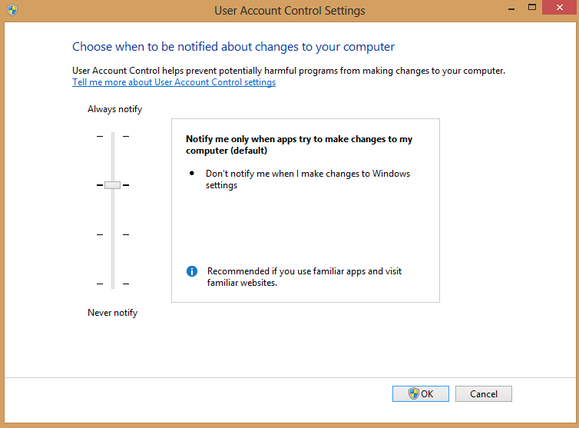
Next, head to User Accounts and Family unit Safety > User Accounts > Change User Business relationship Command settings. A new window pops up with a slider that allows you to fine-tune just how frequently the UAC dialog box volition appear. Don't like the way the screen dims when UAC activates? You lot can ditch that behavior—or you can but plow UAC off completely. (Amusingly, a UAC prompt pops up to ostend that you approve of the UAC changes.)
Delete files that pass up to be deleted
 Unlocker
Unlocker "I'm distressing, Dave, just I can't permit you practise that." Few things are more than irritating than Windows' refusing to delete a file or binder considering some part of that item is in use. The superb Unlocker lets you lot seize control and snuff out those stubborn locked files.
Now, when y'all're faced with a tenacious file, only right-click it and select Unlocker from the context menu. If the file is locked down, Unlocker opens a window that details the active process (or processes) and presents you with several options. Unlocking a procedure removes the lock while leaving the process itself active, whereas killing a process shuts information technology down completely. Once y'all've unlocked or killed the pesky processes, you're free to delete the file or folder in question.
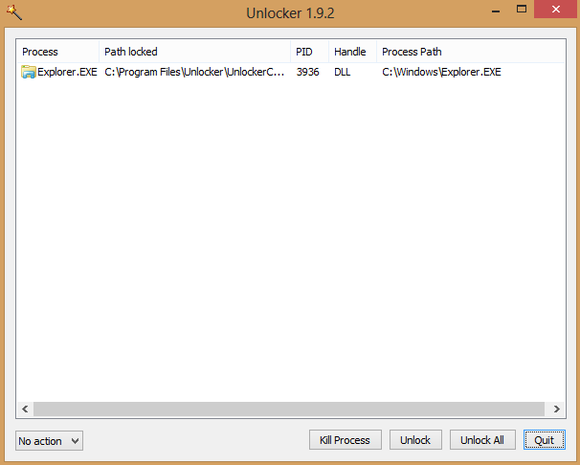
Be careful, though: Killing critical processes and deleting files willy-nilly is a good way to create an unstable system. Apply Unlocker just to delete locked programs that you lot know are safe to scrub.
(Warning: Although Unlocker is excellent, its default Quick settings install unwanted toolbars and muck up your browser's homepage and search provider. Exist certain to pay attention! Select Advanced at the appropriate screen and uncheck those options, or you'll have a whole new hassle.)
Bring back the Start push button
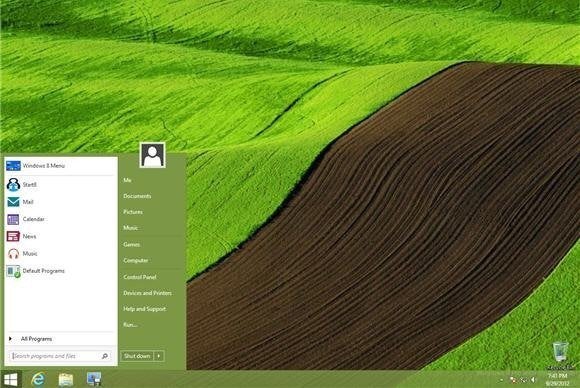
Windows 8 ditched the iconic Showtime button. The Windows 8.one update is slated to bring it back, but that version of the push button will merely drop you onto the mod-UI Commencement screen—Windows 8.one won't be bringing back the Start menu itself. (Thanks, Microsoft.)
If you're having a hard time learning to love live tiles, you can find a ton of stellar Commencement-push replacement programs, all of which bring back the Start button and restore its full Windows 7-style functionality. Our favorites include Start8, Archetype Crush, and Pokki.
While you're decorated snagging software, take hold of the excellent and free VLC media player (and read our guide to mastering it) to brim effectually Windows eight's frustrating refusal to play DVDs natively.
Disable password and lock screens
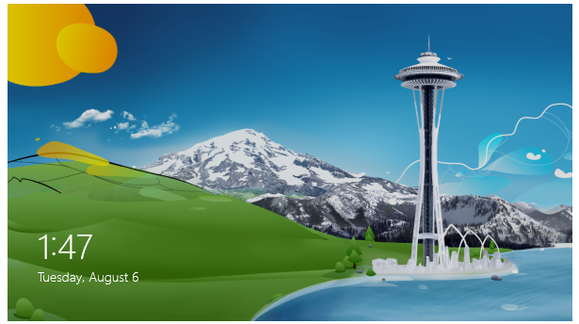
Passwords and lock screens make a lot of sense on portable laptops and touchscreen tablets, but on your personal desktop—safe and secure in your home—they're just speed bumps along the road to computational elation. I especially loathe Windows eight's introduction of a lock screen that has to be dismissed every fourth dimension your device wakes up, a function that simply doesn't belong on non-touchscreen PCs (read: most of them).
To ditch it, press Windows-R on your keyboard to bring up the Run command box. Next, type gpedit.msc and click OK to bring up the Local Grouping Policy Editor. Journey to Computer Configuration > Administrative Templates > Control Panel > Personalization in the file tree on the left side of the window, and then double-click Do Non Display the Lock Screen. Select the Enabled radio push and click OK.
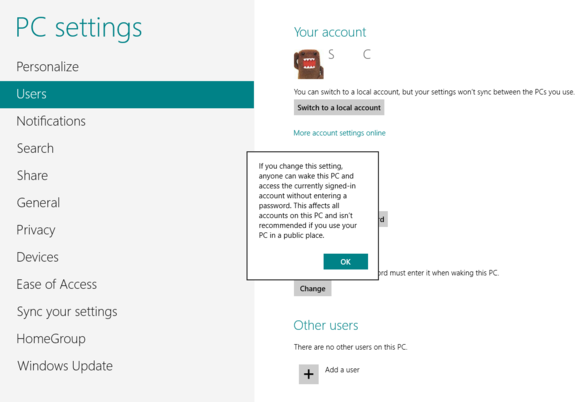
The method for disabling your password varies by Windows version. (Remember: Removing your countersign means that anyone tin sit at your PC and first poking around.) In Windows seven, open the Control Panel and head to User Accounts and Family Safety > User Accounts > Remove your password. Just input your current password, click Remove Password, and y'all're good to go.
In Windows eight, open the right-side Charms bar and then select Settings > Change PC Settings > Users. Hither, click Alter nether the 'Any user who has a password must enter information technology when waking this PC' choice, and click OK in the box that pops up. Boom! Done.
Savour the sound of silence
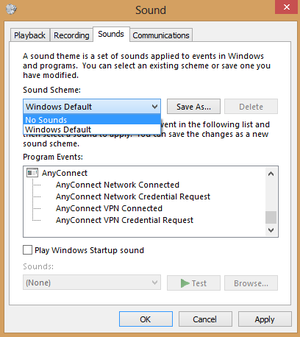
Windows constantly chirps, buzzing in with a cacophony of noises ranging from the lowliest "ding" to the über-annoying sound of a UAC notification. Just leave me to my Spotify playlists in peace, Windows!
To force information technology to do just that, correct-click the volume indicator in the system tray (on the correct side of the taskbar) and select Sounds from the context carte du jour. In the new window that opens, click the Audio Scheme drop-downward carte du jour, select No Sounds, and click OK. Revel in the silence. (Hey, no one ever said all PC annoyances had to be major!)
Speed upward boot times
Windows inevitably becomes bogged down as the months become by. And as more than and more software and services work their tendrils into the startup procedure, your system's kicking fourth dimension suffers in item. Preventing unnecessary software from running at startup can drastically reduce how long your PC takes to get upwardly and at 'em.
First, y'all need to encounter exactly which programs starting time along with your computer. In Windows 7, press Windows-R, blazon msconfig, and press Enter. In the System Configuration window that opens, click the Startup tab.
It'south a bit easier in Windows 8. Printing Ctrl-Shift-Esc to bring up the Windows Chore Manager, and open the Startup tab.
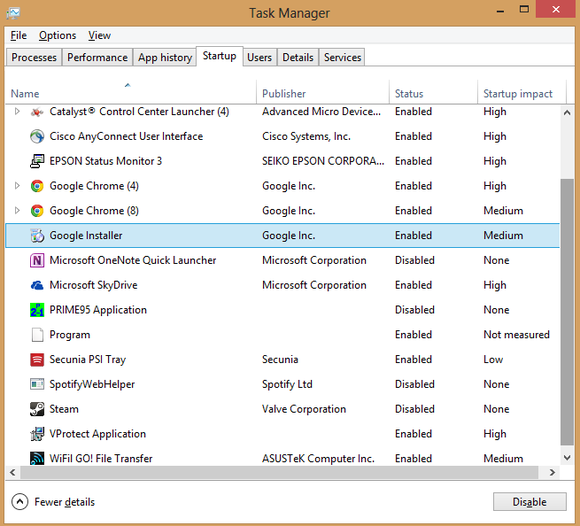
Here, you'll see a list of all the software that activates at your PC's startup. Clear the logjam—and speed up your PC's boot time—by disabling any entries that absolutely, positively don't demand to launch with Windows. In my case (see the screenshot above), I've disabled the startup launches for the OneNote note-taking software, the Steam gaming client, Spotify, and the Prime95 benchmarking program, since I can only open those applications if I want to utilize them.
Don't prevent a process from starting during boot if you aren't certain that information technology'due south superfluous, though. Once, I accidentally disabled startup activation for my laptop's touchpad software, which was a headache all its ain.
Neutering rogue startup programs is the fastest fashion to boost your kicking times, only if you're feeling a need for even more speed, check out PCWorld's nitty-gritty guide to making your PC kick faster.
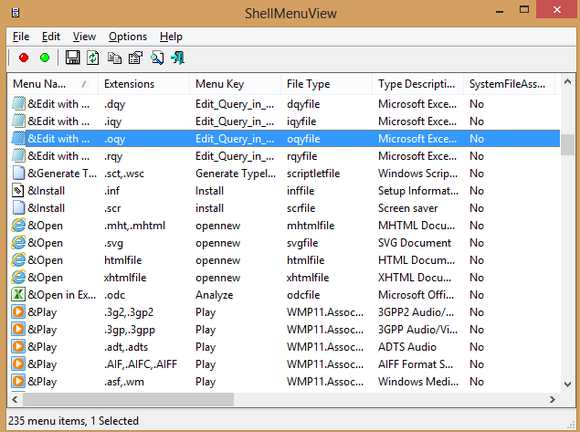
If you've installed enough software to slow downwards startup, chances are good that your PC's right-click context carte is flood with options, as well. Nirsoft'due south excellent ShellExView and ShellMenuView tools display all the carte du jour items that appear in your context menu, and allow yous to disable the ones you don't need.
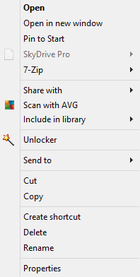
Note that both utilities drill downwardly to a really granular level, displaying even context-carte du jour options that appear only for sure file extensions and programs. Beginning with ShellMenuView, and then hunt down any stragglers with ShellExView. When y'all find a menu option yous want to erase, select it in the list, and click the carmine dot in the Nirsoft toolbar to disable information technology. The green dot reactivates a disabled menu option. (Tip: Use Ctrl-F to quickly search for specific programs.)
Nirsoft'due south tools clean up the context carte du jour by mucking effectually with the Windows Registry, so be sure to back upward the Registry before diving as well deep.
Ensure hassle-costless software updates
Keeping your plethora of programs patched and up-to-date is vital to plugging potential vulnerabilities in your system, but desktop programs don't automatically update in applike fashion. You lot must actively seek out updates for your software—or worse, deal with dozens of automatic-update "helpers" popping up in your face and clogging up system resource. (I'm looking at you, Java Update.)
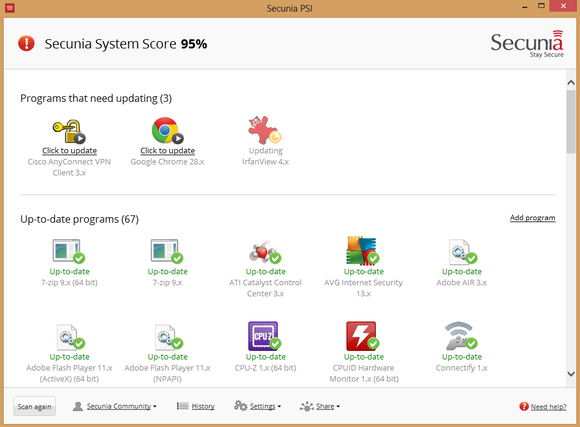
Or yous could just install Secunia Personal Software Inspector. Secunia PSI inventories all the software on your PC and so keeps an eye out for updates. If an update comes along for one of your programs, Secunia attempts to utilise information technology without bothering you. If Secunia PSI can't use the update automatically, it pings you lot to let you know that a new version of the software is available, consummate with a handy-dandy download link.
Wipe away Windows' modernistic await

We've already disabled the Windows 8 lock screen, restored its power to play DVDs, and even brought back the Start button with the help of some 3rd-political party software. If that isn't enough for you lot—if yous actually, truly hate everything virtually Microsoft'due south modern UI—fear not: It is possible to bring a Windows seven look and feel to Windows eight, but that takes a scrap more than piece of work than is possible to fit into a general-advice article such as this.
Check out PCWorld'southward guide to banishing the modern UI from your Windows 8 PC for step-by-step details. Yous might also want to read PCWorld'south 8 worst Windows 8 irritations (and how to set up them).
Seize with teeth back
What frustrates you lot about your PC? Vent in the comments. Who knows? If plenty complaints pile up, some other article may be in guild.
How To Fix 403 Err From Pc,
Source: https://www.pcworld.com/article/453235/how-to-fix-your-pcs-worst-annoyances.html
Posted by: harisowayll.blogspot.com


0 Response to "How To Fix 403 Err From Pc"
Post a Comment